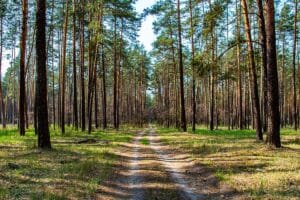Forest carbon can affect timberland values to the extent that robust markets for carbon support reliable cash flows to investors. With wood, the economic value of trees derives from the ability of manufacturers to turn logs into value-added products consistently, at a profit, over time. Without demand, whether from mills or carbon markets, trees have no (economic) value.
Meanwhile, back at the lab, alternate forest carbon markets continue to develop. What is required to evaluate the potential impact of these markets on timberland investors? We must think about plausible long-term structural changes to the forest industry; forest carbon markets could evolve in markedly different ways within the broader carbon economy.
Two Futures
Consider two broad and diverging scenarios. On the one side, forest carbon markets provide a temporary stop-gap measure, a bridge, from current carbon sequestration efforts to a future where global emissions are, thanks to wholesale transitions in energy generation and carbon capture technologies, de minimis, making forest carbon efforts irrelevant on the margin. The gap between the current situation and the future irrelevance would be measured in years or decades.
Alternately, what if we have this backwards? Assume the marketplace decides that trees are more valuable as stores of carbon and sources of other environmental services for the next century or more than they are as a fibrous raw material. In that world, wood users would compete with carbon-centric opportunity costs when procuring logs. Forest owners would require a certain level of payment to offset their carbon storage role, and all wood fiber dependent industries and service providers could face massive disruption.
Analyzing Operable and Viable Futures
Painting a speculative, fact-free story is easier than grinding through data to develop a bottom-up analysis and view of the future. However, to understand what is viable or operable, that is exactly the task at hand. We invest the time required to consider the implications on wood demand and timber prices in the future.
In other words, we want to (1) further our understanding of how carbon markets affect aggregate wood demand and timber supplies in order to (2) provide a view on how the forest industry will be structured and how it may operate. This helps us prioritize investments and connect the dots between investors and their expected cash flows and returns.
Comparing Scenarios
Scenario analysis offers a tool for assessing the relative impact (sensitivity) of wood demand, forest supplies, logistics and technology across potential futures. This type of work helps us stack and rank markets, and depends on a granular understanding of wood-using mills and their relative technological position.
Forest carbon markets build on key economic assumptions, one of which is that it does not matter where (on the planet) a unit of carbon is reduced. Therefore, thinking through future conditions includes a type of “growth-to-drain” or “supply-to-demand” balances by local market and region on continental and global bases. This provides the raw analysis for taking positions on which global regions will lean into their traditional forest industries, which may lean into emerging forest carbon and environmental service opportunities and which may serve as models for integrated approaches.
Forest Fundamentals Still Apply
Forest researchers have expended significant effort improving the growth-and-yield simulations of the key commercial tree species that drive timberland wood flows and cash flows. From a “physical facts” standpoint, these same models support our understanding of the “sequestration capacity” of forests for carbon markets. However, our relative understanding of forest biology is matched by a destabilizing uncertainty associated with forest carbon prices and markets.
When investors decide to acquire and manage timberlands, they rely on estimates of expected returns, not on paranormal psychology or a horoscope. To the extent forest carbon influences capital investment in the wood products industry or forest management decisions moving forward, it will build, in the end, on the detailed bottom-up work required to “operationalize” strategic plans and scenarios.
This content may not be used or reproduced in any manner whatsoever, in part or in whole, without written permission of LANDTHINK. Use of this content without permission is a violation of federal copyright law. The articles, posts, comments, opinions and information provided by LANDTHINK are for informational and research purposes only and DOES NOT substitute or coincide with the advice of an attorney, accountant, real estate broker or any other licensed real estate professional. LANDTHINK strongly advises visitors and readers to seek their own professional guidance and advice related to buying, investing in or selling real estate.










Add Comment